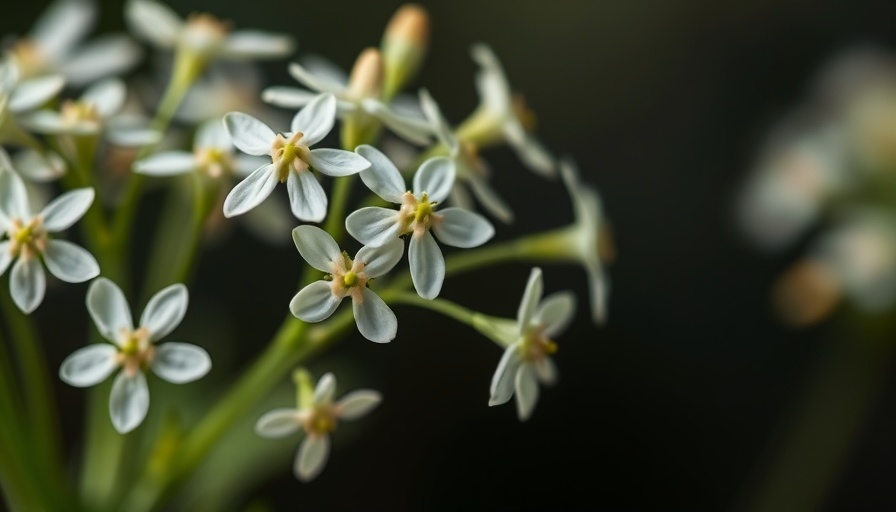
Discover the Delight of Growing Anise in Containers
For home gardeners looking to add a unique flavor to their culinary creations, growing anise (Pimpinella anisum) in pots is a delightful option. Known for its sweet licorice taste, anise is not just an aromatic herb; it’s a vibrant addition to any container garden. Whether you’re an urban dweller or a suburban homeowner, cultivating this herb right on your balcony or patio allows you to enjoy its flavor fresh from your garden.
Cultivation Basics: Key Insights for Thriving Anise
Anise thrives in full sun, requiring six to eight hours of sunlight daily. For optimal growth, it prefers slightly acidic to neutral soil (pH 6.0 to 7.0). When choosing containers, it’s essential to provide enough depth for anise's taproot, which can grow 20 to 24 inches long. A pot at least 12 inches deep will ensure the roots have ample room to establish.
Fast-growing and resilient, anise is an annual herb that needs about 120 frost-free days to mature. As a natural pest repellant, it can deter insects like aphids and cabbage moths, making it an excellent choice for the eco-conscious gardener. Adding anise to your garden can enhance not only your culinary dishes but also promote a healthy garden ecosystem.
Optimal Container Choices for Growth
When selecting containers, gardeners should opt for pots made from materials that provide good drainage, such as clay or unglazed ceramic. This prevents waterlogging, which can harm the sensitive roots of the anise plant. Consider pots with a minimum diameter of 12 to 14 inches to allow adequate space and avoid crowding the roots.
Another aspect to consider is the placement of your pots. Anise plants may benefit from light afternoon shade, especially in regions with intense summer heat, protecting them from potential sun damage while still getting the sun they crave.
Starting from Seed: Techniques for Success
To effectively grow anise from seed, direct sowing is the preferred method. Once the danger of frost has passed, prepare your container’s soil by mixing high-quality potting mix with organic compost. Sow seeds about 1/4 inch deep and maintain consistent moisture during germination, which typically takes 7 to 14 days.
With the right seed starting techniques, your anise plants will flourish, enhancing your culinary adventures with their unique flavor. Be mindful to thin seedlings after they have established; leaving adequate space will ensure healthier growth and development.
Harvesting: When and How to Gather Your Anise
Harvest usually occurs in late summer, around August or September, when the small fruits of the flower clusters begin to turn brown. At this stage, you can cut the stems and hang them upside down in a well-ventilated, dry area. Once fully dried, the seeds can be harvested by gently shaking the stems.
After harvesting, consider using the dried seeds in various dishes, including baked goods, savory stews, or even homemade liqueurs. The versatile uses of anise in the kitchen can transform ordinary meals into extraordinary culinary experiences.
Building Community Connections Through Cultivation
Gardening is not just about growing food; it’s about fostering connections—both to nature and the community. By participating in local gardening groups or sharing your harvest with neighbors, you can cultivate relationships while promoting the benefits of growing your own food.
Consider hosting a potluck where everyone brings a dish featuring freshly grown herbs or vegetables. It’s a fun way to share knowledge and introduce the undeniable joy of home gardening to others.
Inspiration for Your Urban Farm: Embrace the Sweetness of Anise
Growing anise is more than just a gardening project; it's a pathway to embracing a healthier, earth-friendly lifestyle. This beautiful, flavorful herb can enrich your culinary repertoire while providing a sense of accomplishment in nurturing it from seed to harvest.
Are you eager to infuse your garden with the sweet, fragrant essence of anise? Get started today and turn your balcony or patio into a vibrant container garden filled with flavorsome delights.
 Add Row
Add Row  Add
Add 




 Add Row
Add Row  Add
Add 

Write A Comment